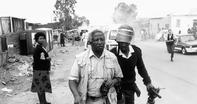
Late 1950’s
Return back in time with Dr Peter Magubane to the late 1950s. He is making his mark on the world. Recently he has covered his first big assignment, on the African National Congress (ANC), for Drum magazine. The editor, Tom Hopkinson is very satisfied with the young cameraman's work.
Peter will continue to work on exposés with Drum writers, such as the 'Nude "Pass" Parade' covering the degrading pass laws and the treatment of black people in South Africa. The following year, Peter wins first and third place in a photographic competition. The white photographer who takes second place refuses to shake his hand.
Despite the rampant prejudices of the period, an unstoppable career is launched. At the same time, Sophiatown is being desecrated, torn to the ground. Along with the other families, his is forcibly removed — uprooted and relocated to Diepkloof.
Covering Momentous Events
During the 1960s and 1970’s, youth in other parts of the world are expressing liberation through music and protests. On home soil, the photojournalist, now in his thirties, is covering momentous events such as the Sharpeville massacre — 'I had never seen so many dead people' — and the Rivonia Trial for Drum magazine.1980s Open International Doors
The 1980s open international doors for the photojournalist Dr Peter Magubane. An assignment for the United Nations High Commissioner for Refugees expands his cause into Africa. 'Through photography I have seen most parts of the world,' he imparts. The starvation he covers in places like Somalia and Ethiopia in this decade 'Hits you right on the forehead.'
At the same time, he works for Time magazine South Africa. On one assignment, in 1985, he covers a student's funeral in Natalspruit. When violence breaks out on that day he is shot seventeen times below the waist with buckshot. Back out on the beat as soon as possible, in 1986, he steps in to save a mother and daughter from an enraged crowd in Leandra.
Nelson Mandela Official Photographer
In 1990, Dr. Peter Magubane is selected as Nelson Mandela's official photographer to chronicle the country's four-year transition to democracy. 'The kind of "political photography" work that I was doing while they were in jail prepared the way for me to be chosen as the photographer who would follow Mandela around until such time that he became President of South Africa.” I was elated!” laughs Peter.
“What more could a photographer want than to be called upon to follow the life of a saint? It was wonderful to be selected from so many photographers to follow this courageous man. I knew that I must do my best to document his life as I see it, up to the time that he became President”.
Many International Accolades
Peter has published sixteen books, three of which were banned in South Africa in the 1970s and 80s: Magubane's South Africa, Black as I Am and Black Child.
During a ceremony in honour of Dr Peter Magubane’s work the comment was made that 'Many airlines cover less territory than Magubane's solo exhibitions!' His subject-matter is equally wide-ranging, from vanishing cultures to post-democracy life in South Africa.
Amidst the many international accolades Peter has received, there is one award that has pride of place on his shelf: the Order for Meritorious Service Class Il, which he received from former President Nelson Mandela in 1999. “I have received many photographic prizes, from this country in the 1950s to numerous international and lifetime achievement awards, but the one I received from Madiba is my most prized possession.
When you have an award from a man of Mandela's stature — what more could you want?” he beams.
 SouthAfrica.co.za hosted a photo exhibition on the legendary photojournalist Peter Magubane’s 100 best photos of Nelson Mandela, as the wo...
SouthAfrica.co.za hosted a photo exhibition on the legendary photojournalist Peter Magubane’s 100 best photos of Nelson Mandela, as the wo... Peter Magubane, one of South Africa's most celebrated cameramen took it all in his stride. He has captured and documented some of the most s...
Peter Magubane, one of South Africa's most celebrated cameramen took it all in his stride. He has captured and documented some of the most s...